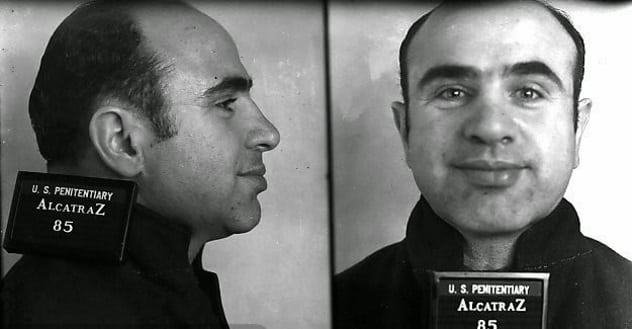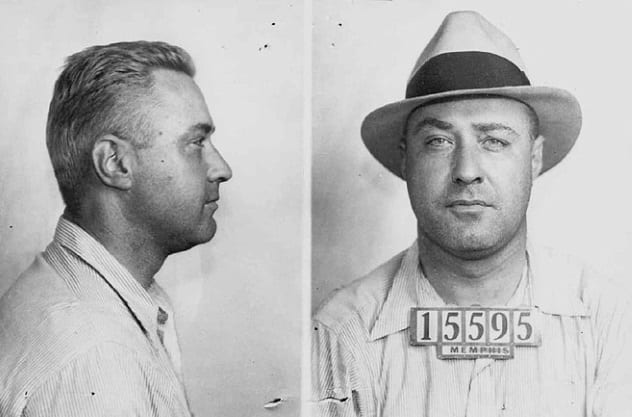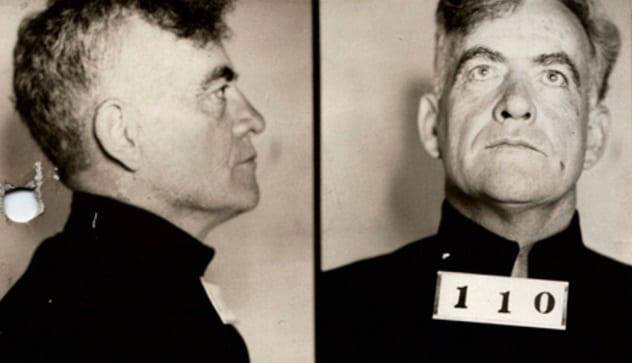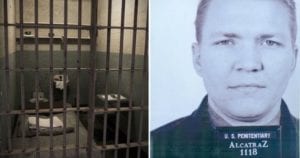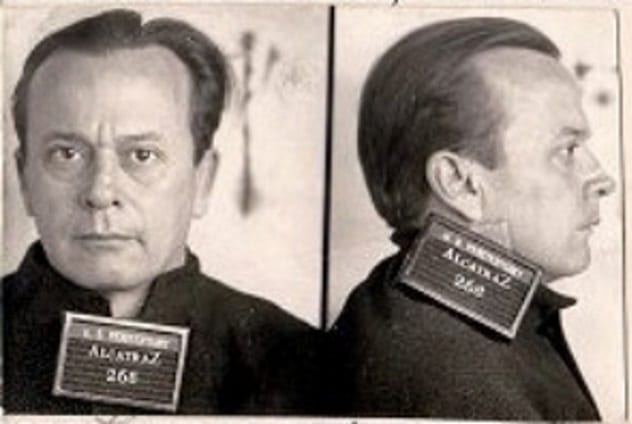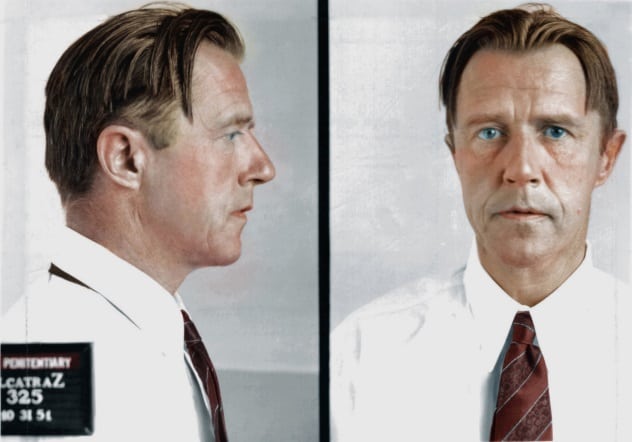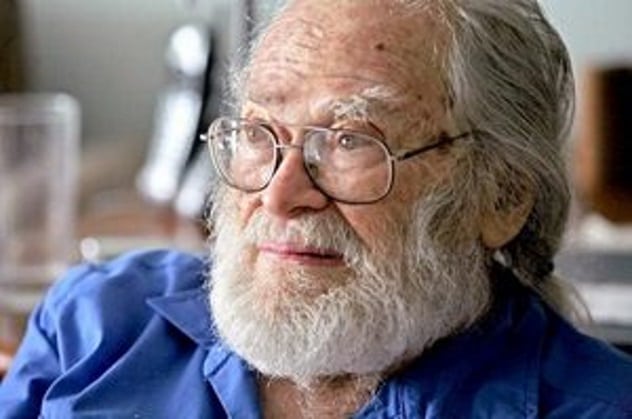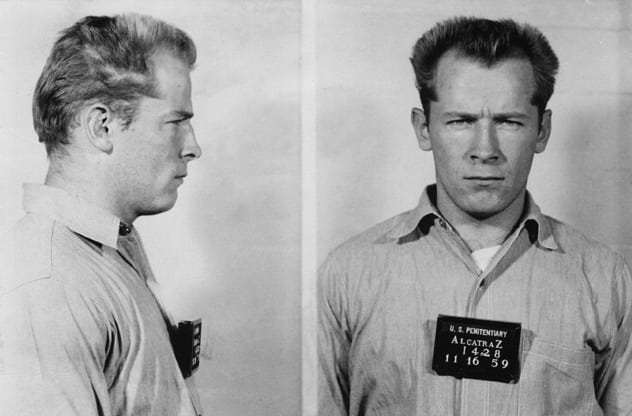In the 1930s, crime was out of control in the United States. In 1932, for example, there were 631 bank robberies. Gangsters would rob a bank, hold a teller hostage, blow up the safe, and make their getaway. In the rural Midwest, the Barker-Karpis gang robbed dozens of banks. They killed anyone who got in their way. In Chicago, Al Capone led a huge crime ring. Not only were these criminals robbing people blind, but they were getting away with it. Gangsters devised new ways to escape prisons. Inmates started riots and attacked guards. So, federal authorities rounded up the worst gangsters, troublemakers, and escape artists from prisons around the United States. Alcatraz Island would be their new home.
10 Al Capone#85
Al Capone made millions of dollars selling illegal liquor. He loved fame, and he sought out reporters and boasted about his exploits. Everyone knew about Al Capone. He was making $60 million a year. He wore double-breasted suits and flashed a diamond ring the size of a golf ball. He drove a 1928 Cadillac Town Sedan protected by 1,360 kilograms (3,000 lb) of steel armor and bulletproof windows. Many people saw him as a hero. He reminded them of Robin Hood, who stole from the rich and gave to the poor. Capone cultivated this reputation. He would donate his crime money to charity and once opened a soup kitchen in Chicago. Government officials suspected Capone was hiring hit men to murder his enemies. On February 14, 1929, seven members of Bugs Malone’s gang were lured to a garage in Chicago. When they arrived, several men disguised as police gunned them down. This became known as the St. Valentine’s Day Massacre. Unable to prove more serious charges, the authorities finally arrested Capone for tax evasion and sent him to the Atlanta Penitentiary. In Atlanta, Capone successfully bribed guards and public officials and received special treatment. Once at Alcatraz, Al Capone was no longer famous. He received no special treatment. He played banjo in the Rock Islanders Band when they gave regular Sunday concerts, and he worked in the laundry room and the library. He said, “Alcatraz has got me licked.”[1]
9 Machine Gun Kelly#117
George “Machine Gun” Kelly came from a wealthy family in Tennessee and attended college. Many people believed his wife, Kathryn, pushed him into a life of crime. Before meeting Kathryn, he had minor skirmishes with the law. She bought him a machine gun and introduced him to notorious gangsters. After their marriage, he became public enemy number one. Kelly robbed banks. The FBI’s wanted posters described him as an “expert machine gunner.” After kidnapping a wealthy oil tycoon, he was sent to Leavenworth Prison in Kansas. After he boasted that he would break himself and his wife out of prison in time for Christmas, authorities took him seriously and shipped him to Alcatraz. On the Rock, he was considered a model prisoner. Although Kelly was known for bragging about crimes he didn’t commit, he served his time quietly, without conflicts or time in solitary. He also served as an altar boy in the prison chapel and worked in the laundry room.[2]
8 Roy Gardner#110
Unlike many criminals of his day, Gardner usually worked alone. He gained fame for robbing trains and was sentenced to 25 years in prison. Nicknamed “The King of the Escape Artists,” he once escaped from a moving train. He also escaped McNeil Island Prison by cutting a hole in the fence and swimming to shore. At Alcatraz, all his attempts to escape were thwarted, but he still managed to be a major pain to the guards. While there, he wrote most of his memoir Hellcatraz: The Rock of Despair. It was one of the first accounts of life inside the prison. He claimed that the Leavenworth and Atlanta prisons were summer resorts compared to Alcatraz.[3]
7 Robert Luke#1118
Robert Luke, prisoner #1118, was sent to Alcatraz in 1954 after several fights and an attempted escape from Leavenworth Prison. Not long after arriving, he couldn’t handle being there, so he flooded his cell and tried to set his mattress on fire. Guards quickly removed Luke from his cell, stripped him naked, and placed him in solitary confinement. He believes he was held there for about 29 days, based on what he ate. He was given bread and water every day and a “meal” of potato, onion, and peas every three days. Luke wrote an autobiography about his time at Alcatraz titled Entombed in Alcatraz in 2010. He also returned to the Rock for a reunion between guards and inmates. From that point, Luke continued to give lectures and tours at Alcatraz. In talking about his experience in prison, he said he became determined to get out of there. “From then on I was on my best behavior, so I got out early. I was one of only six convicts to ever leave Alcatraz directly [without transfer to another prison].” He was released in 1959. Luke’s neighboring cellmate was the famous Alvin “Creepy” Karpis. Luke died in 2017 after having spent more than 50 years free from the famed prison.[4]
6 Arthur ‘Doc’ Barker#268
Barker was a member of the infamous Barker family. Throughout the 1920s and 1930s, Barker and his brother committed innumerable crimes, including robbery, kidnapping, and murder. In 1939, Barker and three inmates attempted to escape Alcatraz. They sawed through four sets of prison bars, concealing the damage with putty. Eventually, they climbed over the high walls of the prison on a foggy night and escaped to the beach. The guards spotted them and ordered them to put their hands in the air. When they didn’t obey, the guards opened fire, hitting them in the legs. Another shot from a patrol boat hit Barker in the head. Barker was recaptured but died of his wounds less than 24 hours later.[5]
5 Alvin ‘Creepy’ Karpis#325
Karpis spent 26 years on Alcatraz, more time than any other prisoner. He began his life of crime at age ten, assisting bootleggers. Karpis was part of the infamous Barker-Karpis Gang, who robbed banks and disrupted mail deliveries. The Barker brothers, Doc and Fred, gunned down innocent bystanders, while Karpis, with a near-genius IQ, was the brains behind the operation. Fellow gang member Fred Hunter described him as “super-smart.” He had a photographic memory. Karpis was not well-liked at Alcatraz. Officer Al Bloomquist called him a nuisance, and Karpis complained frequently and fought with other inmates. He read excessively. They called him “Creepy” because of his sinister smile.[6]
4 Robert Stroud#594
Robert Stroud became famous when Hollywood made a movie called The Birdman of Alcatraz. In the film, he was portrayed as a kind, gentle soul who raised birds in his cell. Actually, he never had birds in his cell at Alcatraz. He studied birds in his cell at Leavenworth Prison in Kansas. While at Leavenworth, Stroud discovered a bird’s nest with baby canaries and took the birds back to his cell to nurse them back to health. Prison authorities granted him permission to raise birds in his cell. At one point, he had 300 of them living in cigar boxes. He created a makeshift lab to develop homemade medicines for them, which he sold through mail order. He also wrote two books about canaries. At Alcatraz, prisoners and guards feared and hated Robert Stroud. Attorney General Biddle said, “Stroud loves birds and hates men.”[7] When The Birdman of Alcatraz came out, many people begged for Stroud’s release. When an officer asked him what he’d do if he were set free, Stroud replied that he had a list of people to kill.
3 Morton Sobell#996
Morton Sobell, along with Ethel and Julius Rosenberg, was convicted on espionage charges. The jury believed all three had supplied a Russian secret agent with classified information on nuclear weapons during the Cold War. FBI director J. Edgar Hoover called it “the crime of the century.”[8] The Rosenbergs were electrocuted at Sing Sing Prison in New York State. Sobell was sentenced to 30 years, and Hoover insisted that Sobell be sent to Alcatraz. Sobell seemed to adjust to Alcatraz better than other inmates. He spent his time reading books from the prison library. He was eventually moved to cell C-342 on the top tier. This cell was warmer than others and had a view of the Golden Gate Bridge. Sobell was popular with other inmates at Alcatraz, possibly because J. Edgar Hoover considered him his archenemy. He was ultimately released from prison in 1969. In 2011, he admitted that he helped copy hundred of pages of secret Air Force documents. He had previously admitted in 2008 to spying for the Soviet Union in World War II. Martin Sobell died in December 2018 at the age of 101.
2 James ‘Whitey’ Bulger#1428
For “Whitey” Bulger, his crimes before Alcatraz were just the beginning. Convicted of armed robbery, his first long-term prison sentence was at the Atlanta Penitentiary, where he volunteered for MKULTRA, an experimental CIA drug program. Inmates were given LSD and other drugs. After plotting a prison escape, he was shipped to Alcatraz in 1959. According to Bulger, Alcatraz was his best prison experience.[9] In a letter to Alcatraz historian Michael Esslinger, he stated, “If I could choose my epitaph on my tombstone, it would be ‘I’d rather be in Alcatraz.’” When Alcatraz was closed in 1962, Bulger was transferred to Leavenworth. After his release in 1965, he returned to South Boston and worked with the Winter Hill Gang. He and his partner, Stephen J. Flemmi, started their own criminal racket. They also worked undercover for the FBI as TEIs (Top Echelon Informants). When Agent John Connolly warned him of the pending arrest in 1994, Bulger fled. Bulger remained a fugitive from 1995 to 2011. In 2000, the FBI’s Boston branch established a unit to focus on finding Bulger, who rose to the top of the Most Wanted list after the death of Osama bin Laden. After searches through Europe, South America, and Asia, they found Bulger living under an alias in Santa Monica, California. He was convicted of 11 murders and given two life sentences. In October 2018, Bulger was transferred to the United States Penitentiary, Hazelton, in West Virginia. Two days later, he was found dead after being beaten by fellow inmates.
1 John And Clarence Anglin#1476 And #1485
When the Anglin brothers turned to crime, they tried not to hurt anybody. When they robbed a business, they chose a time when the business was closed so that no one would get hurt. They robbed banks with only a toy gun. In 1958, they robbed the Columbia Savings Bank in Alabama. After getting caught, John (left above) tried to escape the state penitentiary and got shipped to Alcatraz. After his own escape attempt, Clarence (right above) joined his brother at Alcatraz. On the night of June 11, Frank Morris and the Anglin brothers escaped Alcatraz. They had planned this escape for nine months. Every night for five months, they used discarded saw blades and smuggled cafeteria spoons to burrow into the rotting cement at the back of their cells. They would work from 5:30 pm, when they entered the cell, until 9:00 pm, not long before lights out. They used fake vents to conceal their work from the guards. Meanwhile, they stole 50 raincoats and built a raft. They sewed the raincoats together and sealed them with heat from the steam pipes below their cells. They planned to paddle to nearby Angel Island, steal a boat, and then boost a car. Since they knew the guards would check their cell every hour during the night, the brothers created fake heads from soap, toilet paper, and a homemade cement mix. They painted the heads and decorated them with human hair from the barbershop. They named the decoys Oink and Oscar. On June 11, 1962, Frank Morris and the Anglin brothers crawled out of the back of their cells. They gathered the raft and carried it up to the roof. Then they climbed down the wall and into the bay. That was the last time anyone saw these three men. When the guards got no answer during the morning wake-up call, they pulled back the sheets and discovered the decoys. It is unlikely that the men survived. The water temperature was 12 degrees Celsius (54 °F). The tide was 13 kilometers per hour (8 mph). Pieces of the men’s raft were found in the bay. No boats or cars were reported stolen. Urban legends about their survival continue to this day, though.[10] Lou Hunley has enjoyed sharing books with children as a teacher and children’s librarian. She created Librarian Lou, a blog about children and young adult books. When she’s not reading or writing, she enjoys playing pickleball, biking, and zip-lining.
